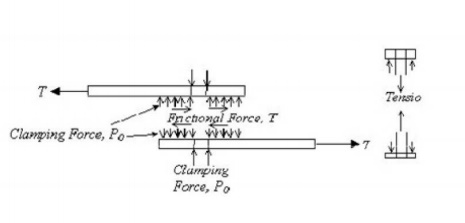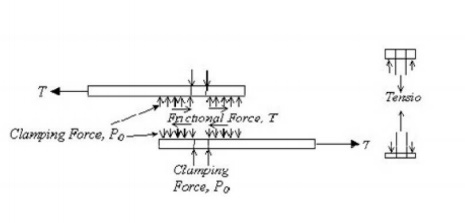Chapter: civil : Design Of Steel Structures
Shear Connections With Bearing Type Bolts

SHEAR CONNECTIONS WITH BEARING TYPE
BOLTS
In this section the
force transfer mechanisms of bearing and friction type of bolted connections
are described.
1. Force transfer of bearing type bolts
Figure 13 shows the
free body diagram of the shear force transfer in bearing type of bolted
connection. It is seen that tension in one plate is equilibrated by the bearing
stress between the bolt and the hole in the plate. Since there is a clearance
between the bolt and the hole in which it is fitted, the bearing stress is
mobilised only after the plates slip relative to one another and start bearing
on the bolt
.The
section x-x in the bolt is critical section for shear. Since it is a lap joint
there is only one critical section in shear (single shear) in the bolt .In the
case of butt splices there would be two critical sections in the bolt in shear
(double shear), corresponding to the two cover plates.
2. Design shear strength of bearing type
bolts
The failure of
connections with bearing bolts in shear involves either bolt failure or the
failure of the connected plates. In this section, the failure modes are
described along with the codal provisions for design and detailing shear
connections. In connections made with bearing type of bolts, the behaviour is
linear until
i) yielding takes place
at the net section of the plate under combined tension and flexure or
ii) shearing takes place at the bolt shear
plane or
iii) failure of bolt
takes place in bearing,
iv) failure of plate
takes place in bearing and
v) block shear failure
occurs. Of these,
i) and will be
discussed in the chapter on tension members. The remaining three are described
below.
3.
Shearing of bolts
The
shearing of bolts can take place in the threaded portion of the bolt and so the
area at the root of the threads, also called the tensile stress area At, is
taken as the shear area As. Since threads can occur in the shear plane, the
area Ae for resisting shear should normally be taken as the net tensile stress
area, An, of the bolts. The shear area is specified in the code and is usually
about 0.8 times the shank area. However, if it is ensured that the threads will
not lie in the shear plane then the full area can be taken as the shear area. A
bolt subjected to a factored shear force (Vsb) shall satisfy as per cl. 10.3.2 of IS 800:2007, where . 10.3.3 of the code.

Here Vnsb = nominal
shear capacity of a bolt, calculated by in which fu =
ultimate tensile strength of a bolt; nn = number of shear planes
with threads intercepting the shear plane; n, = number of shear planes without
threads intercepting the shear plane; Asb = nominal plain shank area
of the bolt; and Anb = net shear area of the bolt at threads, may be
taken as the area corresponding to root diameter at the thread as given in
Table 5 and ?mb = 1.25.
For bolts in single shear, either nn or ns is one and the
other is zero. For bolts in double shear the sum of nn and ns
is two.
Table 5
Tensile area of ordinary bolts (Grade 4.6)
Bolt
size, d (mm) 12 16 20 22 24 27 30 36
Tensile
stress area (mm2) 84.3 157 245 303 353 459 561 817
2.2. Bearing failure
If the connected plates are made
of high strength steel then failure of bolt can take place by bearing of the
plates on the bolts. If the plate material is weaker than the bolt material,
then failure will occur by bearing of the bolt on the plate and the hole will
elongate. The beating area is given by the nominal diameter of the bolt times
the combined thickness of the plates bearing in any direction. A bolt bearing
on any plate subjected to a factored shear force (Vsb) shall satisfy as Vsb < = Vdb per cl. 10.3.2 of IS 800:2007,
where as Vdb = Vdpb = Vnpb/?mb given by cl. 10.3.4 of the code where, ?mb = 1.25
and Vnpb = bearing strength of a bolt, calculated as Vnpb
= 2.5kbdtfu where fu = smaller of the ultimate
tensile stress of the bolt and the ultimate tensile stress of the plate, d =
nominal diameter of the bolt, t = summation of the thicknesses of the connected
plates experiencing bearing stress in the same direction and kb is
smaller of e/3d0, p/3d0-0.25, fub/fu,
1.0 where e, p = end and pitch distances of the fastener along bearing
direction; d0 = diameter of the hole; fub, fu
= Ultimate tensile stress of the bolt and the ultimate tensile stress of the
plate, respectively.
The underlying assumption behind
the design of bolted connections, namely that all bolts carry equal load is not
true in some cases. In long joints, the bolts farther away from the centre of
the joint will carry more load than the bolts located close to the centre.
Therefore, for joints having more than two bolts on either side of the building
connection with the distance between the first and the last bolt
exceeding 15d in the direction of load, the nominal shear
capacity Vns, shall be reduced by the factor,
?lj, given by
(Cl.10.3.2.1) ?lj = 1.075 -
lj / (200 d) but 0.75 < ?lj
<
1.0 where, d= nominal diameter of the bolt Similarly, if
the grip length exceeds five times the nominal diameter, the strength is
reduced as specified in IS 800. In multi-bolt connections, due to hole
mismatch, all the bolts may not carry the same load. However, under ultimate
load, due to high bearing ductility of the plates considerable redistribution
of the load is possible and so the assumption that all bolts carry equal load
may be considered valid.
Related Topics